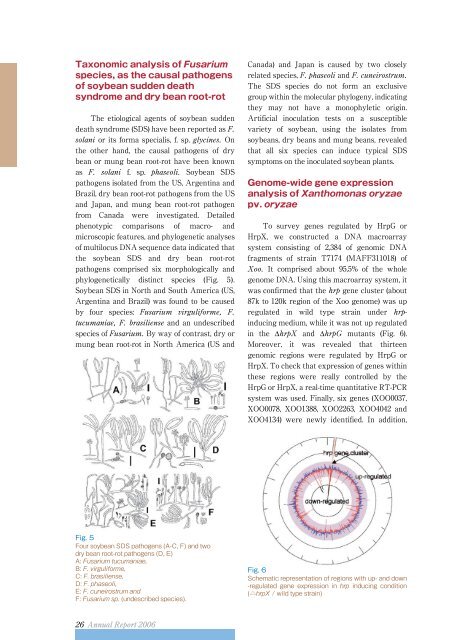Annual Report 2006
Annual Report 2006
Annual Report 2006
Create successful ePaper yourself
Turn your PDF publications into a flip-book with our unique Google optimized e-Paper software.
Taxonomic analysis of <br />
species, as the causal pathogens<br />
of soybean sudden death<br />
syndrome and dry bean root-rot<br />
The etiological agents of soybean sudden<br />
death syndrome (SDS) have been reported as <br />
or its forma specialis, f. sp. On<br />
the other hand, the causal pathogens of dry<br />
bean or mung bean root-rot have been known<br />
as f. sp. Soybean SDS<br />
pathogens isolated from the US, Argentina and<br />
Brazil, dry bean root-rot pathogens from the US<br />
and Japan, and mung bean root-rot pathogen<br />
from Canada were investigated. Detailed<br />
phenotypic comparisons of macro- and<br />
microscopic features, and phylogenetic analyses<br />
of multilocus DNA sequence data indicated that<br />
the soybean SDS and dry bean root-rot<br />
pathogens comprised six morphologically and<br />
phylogenetically distinct species (Fig. 5).<br />
Soybean SDS in North and South America (US,<br />
Argentina and Brazil) was found to be caused<br />
by four species: <br />
and an undescribed<br />
species of By way of contrast, dry or<br />
mung bean root-rot in North America (US and<br />
Canada) and Japan is caused by two closely<br />
related species, and <br />
The SDS species do not form an exclusive<br />
group within the molecular phylogeny, indicating<br />
they may not have a monophyletic origin.<br />
Artificial inoculation tests on a susceptible<br />
variety of soybean, using the isolates from<br />
soybeans, dry beans and mung beans, revealed<br />
that all six species can induce typical SDS<br />
symptoms on the inoculated soybean plants.<br />
Genome-wide gene expression<br />
analysis of <br />
pv. <br />
To survey genes regulated by HrpG or<br />
HrpX, we constructed a DNA macroarray<br />
system consisting of 2,384 of genomic DNA<br />
fragments of strain T7174 (MAFF311018) of<br />
It comprised about 95.5% of the whole<br />
genome DNA. Using this macroarray system, it<br />
was confirmed that the gene cluster (about<br />
87k to 120k region of the Xoo genome) was up<br />
regulated in wild type strain under inducing<br />
medium, while it was not up regulated<br />
in the ∆ and ∆ mutants (Fig. 6).<br />
Moreover, it was revealed that thirteen<br />
genomic regions were regulated by HrpG or<br />
HrpX. To check that expression of genes within<br />
these regions were really controlled by the<br />
HrpG or HrpX, a real-time quantitative RT-PCR<br />
system was used. Finally, six genes (XOO0037,<br />
XOO0078, XOO1388, XOO2263, XOO4042 and<br />
XOO4134) were newly identified. In addition,<br />
Fig. 5<br />
Four soybean SDS pathogens (A-C, F) and two<br />
dry bean root-rot pathogens (D, E)<br />
A: <br />
B: <br />
C: <br />
D: <br />
E: <br />
F: (undescribed species).<br />
Fig. 6<br />
Schematic representation of regions with up- and down<br />
-regulated gene expression in inducing condition<br />
( / wild type strain)













